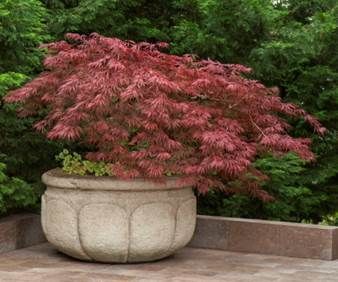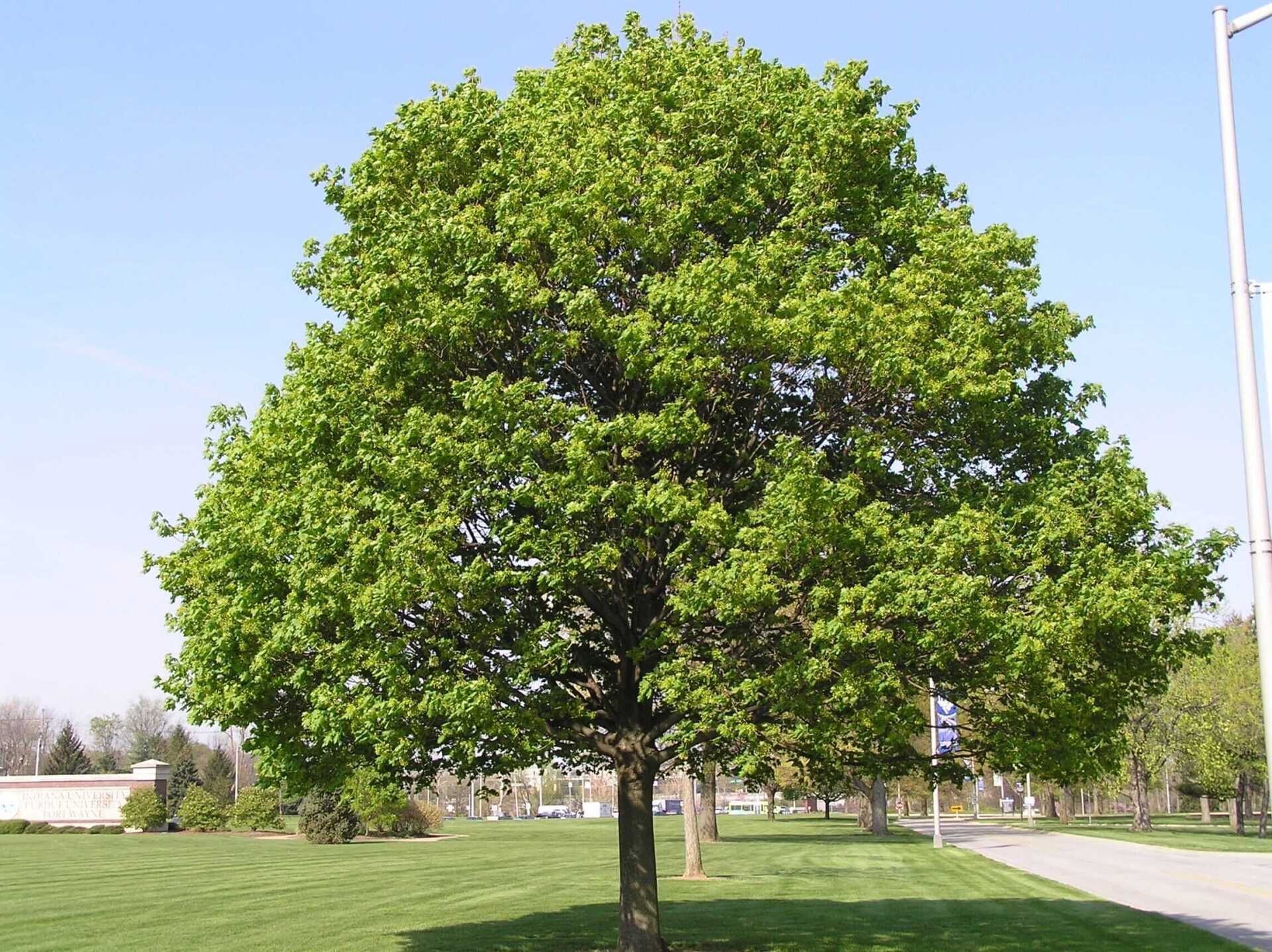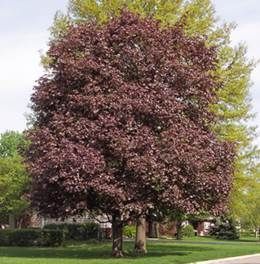How to Pick the Best Maple Tree for a Minnesota Yard
The Best 2 Varieties of (Shade Tree Form) Maple Trees for MN Yards
- We recommend going with either a Sugar Maple ‘Acer Saccharum’ or a Red Maple ‘Acer Rubrum’ variety maple tree. These types of maple trees have the best combinations of beautiful fall colors and ideal growth form size/shape for a shade tree in your lawn.
- What size works best for a shade tree? Look for varieties that grow at least 30’ wide and 40’ tall if you want a traditional shade tree form, many good options will be around 40’ wide and 50’ tall, although it can take at least 10-15 years for most of them to reach even half that size. Narrower cultivars will not look as nice as stand-alone trees in the yard and will not provide the filtered shade and desirable form of a traditional shaped shade tree.
Sugar maples
Sugar maples, also commonly called rock maples or hard maples, tend to have golden to orange fall color, with some ranging into tones of red as well. Sugar maples are native to Minnesota and there are many improved cultivar options available with different shapes, sizes and fall color tone ranges, here just are a few of them that work well in the twin cities, MN metro area.
- ‘Fall Fiesta’ Maple
- ‘Unity’ Maple
- ‘Northern Flare’ Maple
- ‘Autumn Fest’ Maple
- ‘Green Mountain’ Maple

Red Maple Tree
Red maples have striking red fall foliage. There are many great cultivar options, here are a just few of them to choose from that work great in the Minneapolis and St. Paul metro areas:
- ‘Red sunset’ Maple
- ‘Autumn Radiance’ Maple
- ‘Northwood’ Maple

Information on Other Maples Tree Variety Options for MN
Norway maples
Norway Maples
(Acer Platanoides)
are very nice-looking maple trees with a good growth form and size for a for use as a shade tree in Minnesota. They are typically fast growing and can tolerate many adverse growing conditions, like poor soil and heat stress, which is why they are often used as a street or boulevard trees in Minneapolis and St. Paul.
One of the drawbacks to Norway maples compared to a red or sugar maples, is that Norway maples generally do not have nearly as impressive of fall color as the red or sugar maples. Norway maples leaves stay mostly light green to light yellow until dropping in fall.
They are also well known to have extremely dense leafing canopy’s that produce heavy shade around the base of the tree, this can make growing thick grass below a mature Norway maple challenging. However, the dense shade problem can be mostly mitigated by pruning lower branches to raise the height of the canopy as well as pruning to thin the canopy.
It should be mentioned that younger Norway maple trees, say anything less than 15-20 years old usually aren’t large/dense enough to cause shade issues in the lawn space below them. Most Norway maples have green leaves throughout the growing season, however some like the ‘Crimson maple’ maintain burgundy colors leaves all throughout the season which makes for a unique look.
Silver Maples
Silver maples are fast growing, can thrive in wet soil conditions and are also referred to as soft maple, river maple, swamp maple or silver leaf maple. We don’t recommend planting standard silver maples as shade tree in your lawn. Silver maples were a top choice for builders and homeowners in new suburban home developments back in the 1980’s, because they grow so quickly. However, silver maples are very rarely planted these days because of the following drawbacks to selecting a silver maple for your yard: they do not have any notable fall color, they have shallow roots which lifts the soil around the base of the trunk, the roots become exposed in the lawn and last but not least; silver maple trees have weak branches angles that are prone to breaking and require a lot of clean-up and tree trimming to maintain an acceptable tree form.
- Silver Maples Hybrids - Silver maples have since been crossbreed with other more desirable maples, such as the red maple in order to combine the fast growth rate of the silver maple with the desirable fall color of a red maple. Crossbreeding between red and silver maple varieties has created some of the best-selling and most popular new maple tree varieties including the ‘Autumn Blaze’ Maple.
Amur Maples
Amur maples
(Acer Ginnala)
are not a great choice for a shade tree in lawns space because of their small/midsized growth habit. Basically, the canopy of an amur maple is typically too low to mow around without massive amounts of trimming and they look more like a large bush than a nice shade tree. Amur maple trees are typically around 15’ to 20’ wide and 15’ to 20’ tall. Amur maples have messy branching structures, with lots of suckering shoots on branches, which requires a lot of trimming/pruning to keep “clean looking” in landscaped spaces. The seeds can also be very invasive making for lots of volunteer tree amur trees in adjacent landscapes. With all of this being said, Amur maples may have arguable to the most brilliant and impressive fall colors of all the maple varieties.
Japanese Ma
ple
Japanese maples
(Acer Palmatum)
prefer warm climates are almost all of them are not cold hardy in our zone 4 Minnesota climate. There are many options hardy for zone 5, which some people attempt to use in Minnesota with winter protection and covering, which we believe is a mistake and doomed to fail in the long run since MN is mostly rated zone 4. With all of this being said, the only zone 4 rated Japanese maple option we are currently aware of is the ‘Japanese velvet King’ maple but it’s a bush or shrub form best used landscaping bed spaces, at 4’ tall and 4’ wise when mature its a shrub not a shade tree. Also, even in zone 5 and above most Japanese maples are small trees that don’t make for desirable shade tree in the lawn spaces.

- Japanese Maple Hybrid (Minnesota cold hardy Jap. Maple)
The ‘Northwind’ maple is a crossbred cultivar between a Japanese maple (Acer palmatum) and a Korean maple (Acer pseudosieboldianmum) that is rated zone 4 hardy. Other similar hybrid options exist including the ‘Korean northern glow’ and ‘Korean artic Jade’. The goal in crossbreeding these maples was basically to create a “Japanese maple looking” tree cultivar that is cold hardy enough to survive Minnesota’s zone 4 harsh winters. At roughly 15’ to 20’ tall and 15’ wide when mature (it could easily take 15+ years to get that large), these are ornamental type trees rather than traditional large shade trees.

















